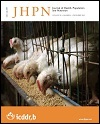Arsenic in Eggs and Excreta of Laying Hens in Bangladesh: A Preliminary Study
DOI:
https://doi.org/10.3329/jhpn.v30i4.13290Keywords:
Arsenic, Drinking-water, Egg, Excreta, Feed, Laying hen, BangladeshAbstract
The aim of this study was to detect arsenic concentrations in feed, well-water for drinking, eggs, and excreta of laying hens in arsenic-prone areas of Bangladesh and to assess the effect of arsenic-containing feed and well-water on the accumulation of arsenic in eggs and excreta of the same subject. One egg from each laying hen (n=248) and its excreta, feed, and well-water for drinking were collected. Total arsenic concentrations were determined by atomic absorption spectrophotometer, coupled with hydride generator. Effects of arsenic-containing feed and drinking-water on the accumulation of arsenic in eggs and excreta were analyzed by multivariate regression model, using Stata software. Mean arsenic concentrations in drinkingwater, feed (dry weight [DW]), egg (wet weight [WW]), and excreta (DW) of hens were 77.3, 176.6, 19.2, and 1,439.9 ppb respectively. Significant (p<0.01) positive correlations were found between the arsenic contents in eggs and drinking-water (r=0.602), drinking-water and excreta (r=0.716), feed and excreta (r=0.402) as well as between the arsenic content in eggs and the age of the layer (r=0.243). On an average, 55% and 82% of the total variation in arsenic contents of eggs and excreta respectively could be attributed to the variation in the geographic area, age, feed type, and arsenic contents of drinking-water and feed. For each weeks increase in age of hens, arsenic content in eggs increased by 0.94%. For every 1% elevation of arsenic in drinking-water, arsenic in eggs and excreta increased by 0.41% and 0.44% respectively whereas for a 1% rise of arsenic in feed, arsenic in eggs and excreta increased by 0.40% and 0.52% respectively. These results provide evidence that, although high arsenic level prevails in well-water for drinking in Bangladesh, the arsenic shows low biological transmission capability from body to eggs and, thus, the value was below the maximum tolerable limit for humans. However, arsenic in drinking-water and/or feed makes a significant contribution to the arsenic accumulations in eggs and excreta of laying hens
DOI: http://dx.doi.org/10.3329/jhpn.v30i4.13290
J HEALTH POPUL NUTR 2012 Dec;30(4):383-393
Downloads
195
180

